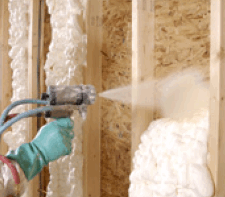Heat Transfer
 The testing to determine R-Value is done in a very controlled environment where heat transfer is measured in terms of conduction heat properties only, not convection or radiant. Conduction is the thermal transfer of heat through a material like the handle of a pot when the pot is heated. Radiant transfer is the transfer of heat through the air waves like the sun's radiant heat in the summer. The third type of heat transfer is convection which uses air movement to transfer heat like a fan-assisted space heater. The R-value test does not test for convection or radiant, only conductive, heat transfer. The R value system's standard is based on 1 inch of yellow pine which equals R-1.
The testing to determine R-Value is done in a very controlled environment where heat transfer is measured in terms of conduction heat properties only, not convection or radiant. Conduction is the thermal transfer of heat through a material like the handle of a pot when the pot is heated. Radiant transfer is the transfer of heat through the air waves like the sun's radiant heat in the summer. The third type of heat transfer is convection which uses air movement to transfer heat like a fan-assisted space heater. The R-value test does not test for convection or radiant, only conductive, heat transfer. The R value system's standard is based on 1 inch of yellow pine which equals R-1.
You may ask if convection occurs in our homes since we have doors and windows which appear to prevent air penetration from outside. With windows, doors, dormers, utility entrances, overhangs, sunrooms and decks; it is virtually impossible to seal the building envelope completely. Air seeping in can set up convection currents, and most houses built today use insulation which performs poorly under convective conditions. Among these are fiberglass, cellulose, mineral wool, perlite, and cotton. All of these products allow warm or cold air to transfer though the insulation material. In the winter, this may cause cold spots on your floors, walls, ceilings or electrical boxes.





